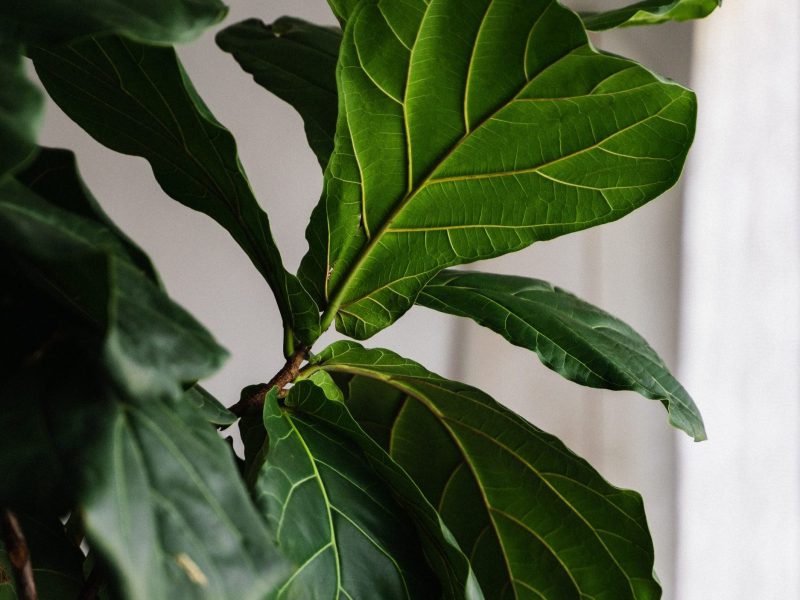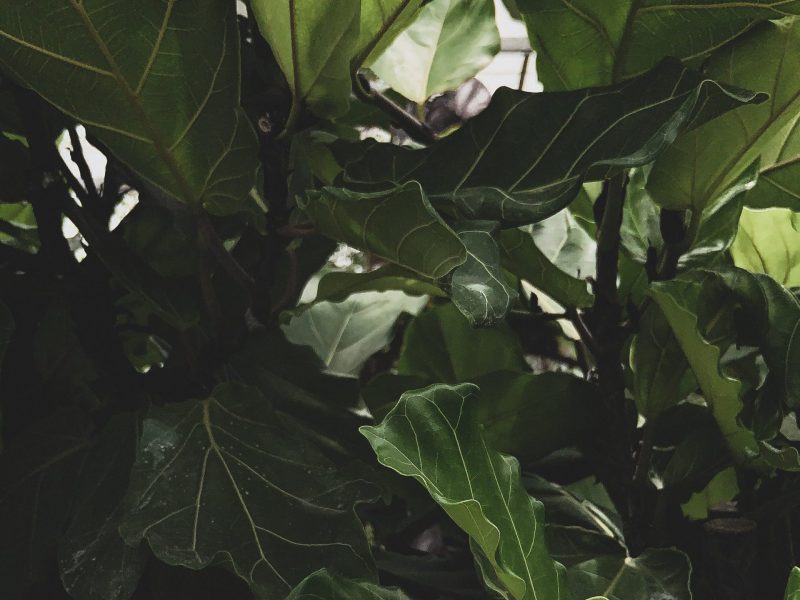Fiddle Leaf Fig Tree Leaf

Fiddle Leaf Fig Trees have become one of the most popular choices for an indoor plant, mostly due to their large elegant leaves and minimalist aesthetic. However, as with any plant type, caring for your Fiddle Leaf Fig Tree isn’t always a breeze and you may come across some issues from time to time.
One of the most common problems for your Fiddle Leaf Fig Tree to be susceptible to is burnt leaves. This can appear as yellow patches or spots across the plant, or concentrated on the leaf tips.
You will be happy to know that although burnt leaves are a very stressful problem to have, they are a lot easier to diagnose than some other issues. This is because there are only really two main causes of burnt leaves on a Fiddle Leaf Fig Tree.
In this article, we will discuss not only the two common causes of burnt Fiddle Leaf Fig Tree leaves but also how to treat and prevent the issue.
Common Causes of Burnt Fiddle Leaf Fig Tree Leaves
Intense direct sunlight
One primary cause of burnt leaves on a Fiddle Leaf Fig Tree is exposure to too much direct sunlight. This typically happens during summer when the sun is stronger and shines for longer each day compared to autumn and winter.
You won’t often really get this issue during winter as the sun isn’t as intense so you’re able to place your Fiddle Leaf Fig Tree a lot closer to the window without any risk of sunburn. So if this is happening during winter, it’s likely not caused by the sun’s intensity.
To identify the cause and make a diagnosis during summer, observe your Fiddle Leaf Fig Tree’s environment throughout the day, as it may be receiving intense sunlight in the afternoon without your knowledge.
Too much fertilizer
The second cause of burnt leaves in a Fiddle Leaf Fig Tree is over-fertilization. This may happen if you are fertilizing your plant too deeply or too often.
One thing to note when making the diagnosis in winter or autumn is that any fertilization will be too much. This is the dormant phase of the year which means your Fiddle Leaf Fig Tree won’t be producing any new growth. Fertilizing during this time can be really damaging.
Since there is no one-size-fits-all amount for fertilization, it can be challenging to determine the right amount for your individual Fiddle Leaf Fig Tree. Factors such as light levels, pot size, plant size, and age can all affect how much fertilizer your plant needs.
However, if you are fertilizing more than the recommended amount stated on the bottle, then it’s likely the cause of the burnt leaves.
Signs of Burnt Fiddle Leaf Fig Leaves
Here’s what to look out for across the leaves as an indication that your Fiddle Leaf Fig Tree is developing burnt leaves.
Small brown or yellow spots across the leaves
If you notice brown and yellow spots on your Fiddle Leaf Fig’s leaves, then this is a possible indication of leaf burn due to overexposure to light or over-fertilization. Spotting the issue early is will make solving and preventing the problem so much easier so make sure to be checking over your plant regularly.
We don’t recommend removing the leaves with small spots as they still contribute to the photosynthesis process. However, if a majority of the leaf is affected, then it is best to remove it from your Fiddle Leaf Fig Tree.
Brown and yellow leaf tips
If your Fiddle Leaf Fig’s leaves have developed burnt yellow or brown tips, this may be due to over-fertilization rather than lighting issues. If the leaf tips are only dry and brown, it could be caused by watering or humidity issues, but yellow halos around the brown tips can indicate over-fertilization.
Large yellow patches across your Fiddle Leaf Fig
If your Fiddle Leaf Fig is displaying large yellow burnt patches on its leaves, it may indicate that the problem has been present for a while. If the issue is progressing rapidly, it could mean that intense direct sunlight is the cause rather than over-fertilization. Burnt patches caused by fertilizer issues take a while to develop into large patches.
It’s also worth looking at where the yellow burnt patches are on your Fiddle Leaf Fig Tree as sunlight will mostly cause burnt patches on the side that faces the sun.
Curling or wilting of leaves
If you notice that the burnt yellow leaves on your Fiddle Leaf Fig Tree are also curling or wilting, then this suggests that the problem is quite severe and has gone undetected for a long period of time.
Brittle or dry leaves
Burnt Fiddle Leaf Fig leaves can feel brittle and dry when touched. This is more prevalent with lighting issues as the heat from the sun can quickly dry out the leaves. Over-fertilization however, won’t dry out the leaves quite in the same way.
Your Fiddle Leaf Fig is losing leaves
When the issue has persisted for an extended period, burnt leaves will naturally fall off your Fiddle Leaf Fig Tree. Once the leaf is dead, your plant can no longer use it for photosynthesis which is why it will shed it.
We recommend that you trim off leaves that are mostly or entirely burnt to redirect the energy that your Fiddle Leaf Fig was using to keep the leaves alive into healthy green foliage.
Solutions to Help Burnt Fiddle Leaf Fig Tree Leaves
After successfully identifying why your Fiddle Leaf Fig Tree leaves are burnt, it’s time to take the necessary steps to begin solving the problem. The longer you wait, the more harm it can cause to your plant which is why it’s super important to figure out the issue early and take the needed steps straight away.
Adjust the position of your Fiddle Leaf Fig Tree
To protect your Fiddle Leaf Fig Tree from intense direct sunlight, you need to find a more appropriate spot for it to live during the summer months. Ideally, the plant should be placed in an area where it can get sufficient sunlight, but the light should be indirect, without any sun rays actually hitting the leaves in the middle of the day.
Sometimes you can get away with a bit more direct sunlight in the morning or evening as it’s a lot weaker but it’s better not to risk it with an already damaged and burnt Fiddle Leaf Fig Tree.
It’s also necessary to consider the positioning of your Fiddle Leaf Fig Tree throughout the year. The spot that was perfect in winter may be too bright in summer so make sure to monitor the environment across the year and make any needed position changes.
Flush out the soil
If the problem is caused by overfertilization and you have used liquid fertilizer, flushing out the soil can be the best way to let your plant begin the recovery process.
You can do this by placing your Fiddle Leaf Fig Tree in the shower and running water through it for a few minutes. Flushing the soil will help remove the excess fertilizer, which is causing the leaves to burn. When doing this, make sure to let the soil drip dry before returning it to the shower to prevent any root rot risks.
Replace the potting mix
If you have used fertilizer pellets that are mixed into the soil, the only solution is to replace the potting mix with fresh soil. However, if you have used fertilizer spikes, it’s easy to solve the issue as you simply remove them!
Preventing Burnt Leaves on your Fiddle Leaf Fig
To prevent burnt leaves from recurring on your Fiddle Leaf Fig Tree plant, it’s important to take further steps after solving the initial issue. Here are some tips to follow:
Adjust the fertilization schedule
If over-fertilization is causing the burnt leaves on your Fiddle Leaf Fig Tree, reduce how often you fertilize your plant moving forward. You also need to avoid fertilizing during autumn and winter as the plant is dormant, unless there are specific factors such as living in a particularly warm climate that mean the fertilizer window is increased.
Increase how much you dilute the fertilizer
In addition to reducing how frequently you fertilize, reduce how deeply you feed your Fiddle Leaf Fig Tree to treat burnt leaves. With spikes or pellets, use less each time or break them in half if using a stronger variety. When using liquid fertilizer, just add less to the same amount of water as before.
Monitor your plant’s health
Regularly check your Fiddle Leaf Fig Tree for any early warning signs of issues before they cause irreversible damage. Spotting the issue early gives you the best shot at treating it easily so a monthly checkup is a must.
We hope that this guide has helped you to figure out not only the cause of the burnt leaves on your Fiddle Leaf Fig Tree, but also learn what the best method of treatment is. Do note that the burnt patches on the leaves will not turn green again even after you’ve taken the steps to solve the issue. These are simply ways to prevent more leaves from being burnt.
To learn more about how to keep your plant happy and problem-free, check out our Fiddle Leaf Fig Tree care guide.














